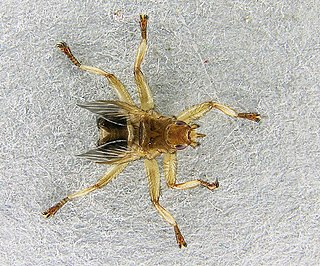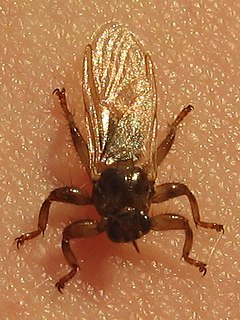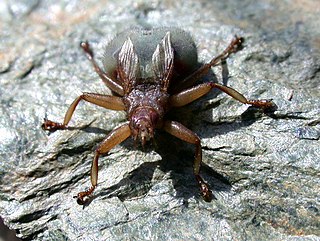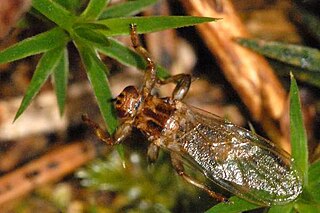
Hippoboscidae, the louse flies or keds, are obligate parasites of mammals and birds. In this family, the winged species can fly at least reasonably well, though others with vestigial or no wings are flightless and highly apomorphic. As usual in their superfamily Hippoboscoidea, most of the larval development takes place within the mother's body, and pupation occurs almost immediately.

Lipoptena is a genus of Hippoboscidae, known as louse flies or keds.

Crataerina is a genus of louse flies in the family Hippoboscidae. All are parasites of birds, feeding on the blood of various species of Apodidae (swifts) and Hirundinidae. The genus is sometimes spelled Craterina.
Hippoboscinae is a subfamily of the fly family Hippoboscidae. All are parasitic, and unlike some other members of the Hippoboscidae, all Hippoboscinae are winged species.

Hippobosca is a genus of flies in the family Hippoboscidae. There are seven known species. There are numerous synonyms.

Pseudolynchia are genus of biting flies in the family of louse flies, Hippoboscidae. There are 5 known species. One of the more well known species is the pigeon louse flyPseudolynchia canariensis. All species are parasites of birds.
Stilbometopa are genus of biting flies in the family of louse flies, Hippoboscidae. There are 5 known species. All species are parasites of birds.
Microlynchia is a genus of biting flies in the family of louse flies, Hippoboscidae. There are four known species. All species are parasites of birds. Microlynchia differs from Pseudolynchia in the presence of minute ocelli and a differently shaped scutellum.
Ortholfersia is a genus of biting flies in the family of louse flies, Hippoboscidae. There are 4 known species. All species are parasites of macropods.

Icosta are genus of biting flies in the family of louse flies, Hippoboscidae. There are 52 known species, making it the largest Hippoboscid genus. All species are parasites of birds.
Allobosca is a genus of biting flies in the family of louse flies, Hippoboscidae. There is only one known species, Allobosca crassipesSpeiser, 1899. It is a parasite of lemurs. It has only rudimentary wings.

Melophagus is a genus of biting flies in the family of louse flies, Hippoboscidae. There are three known species and one subspecies. All are parasites of bovids. All are wingless.
Austrolfersia is a genus of biting flies in the family of louse flies, Hippoboscidae. There is only one known species, Austrolfersia ferrisiBequaert, 1953. It is a parasite of Diprotodontia.
Phthona is a genus of biting flies in the family of louse flies, Hippoboscidae. There are 3 known species. All are parasite of falconets of the genus Microhierax.
Ornithoica are genus of biting flies in the family of louse flies, Hippoboscidae. There are 23 known species. All species are parasites of birds.

Ornithomya are genus of biting flies in the family of louse flies, Hippoboscidae. There are 29 known species. All species are parasites of birds.
Myophthiria is a genus of biting flies in the family of louse flies, Hippoboscidae. There are 13 known species. All species are Parasites of birds.
Ornithoctona are genus of biting flies in the family of louse flies, Hippoboscidae. There are 12 known species. All species are parasites of birds.
Ornithophila are a genus of biting flies in the family of louse flies, Hippoboscidae. There are two known species. Both species are parasites of birds.

Ornithomyinae is a subfamily of the fly family Hippoboscidae. All are blood feeding parasites, for the most part on birds, though some have mammals as hosts.








